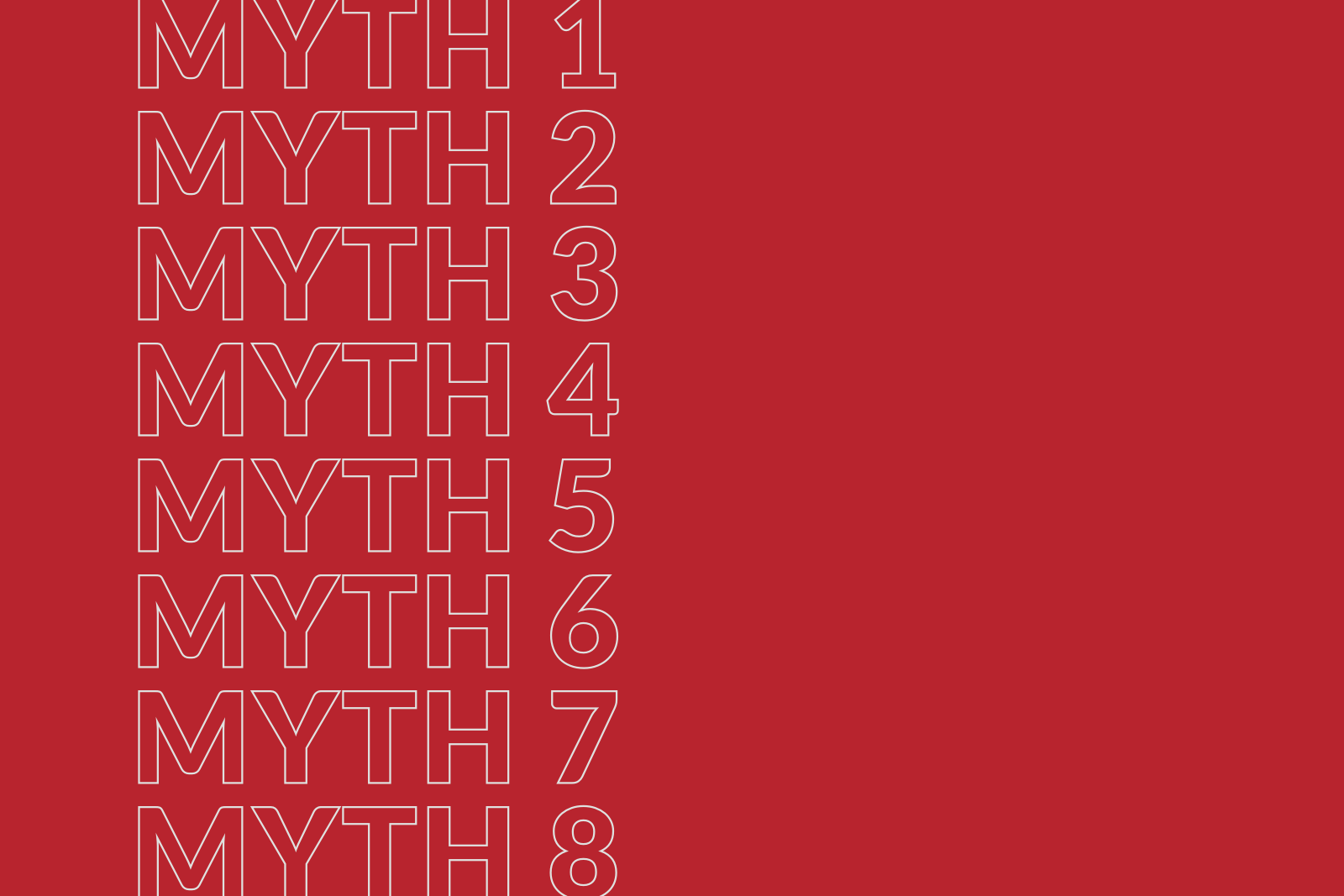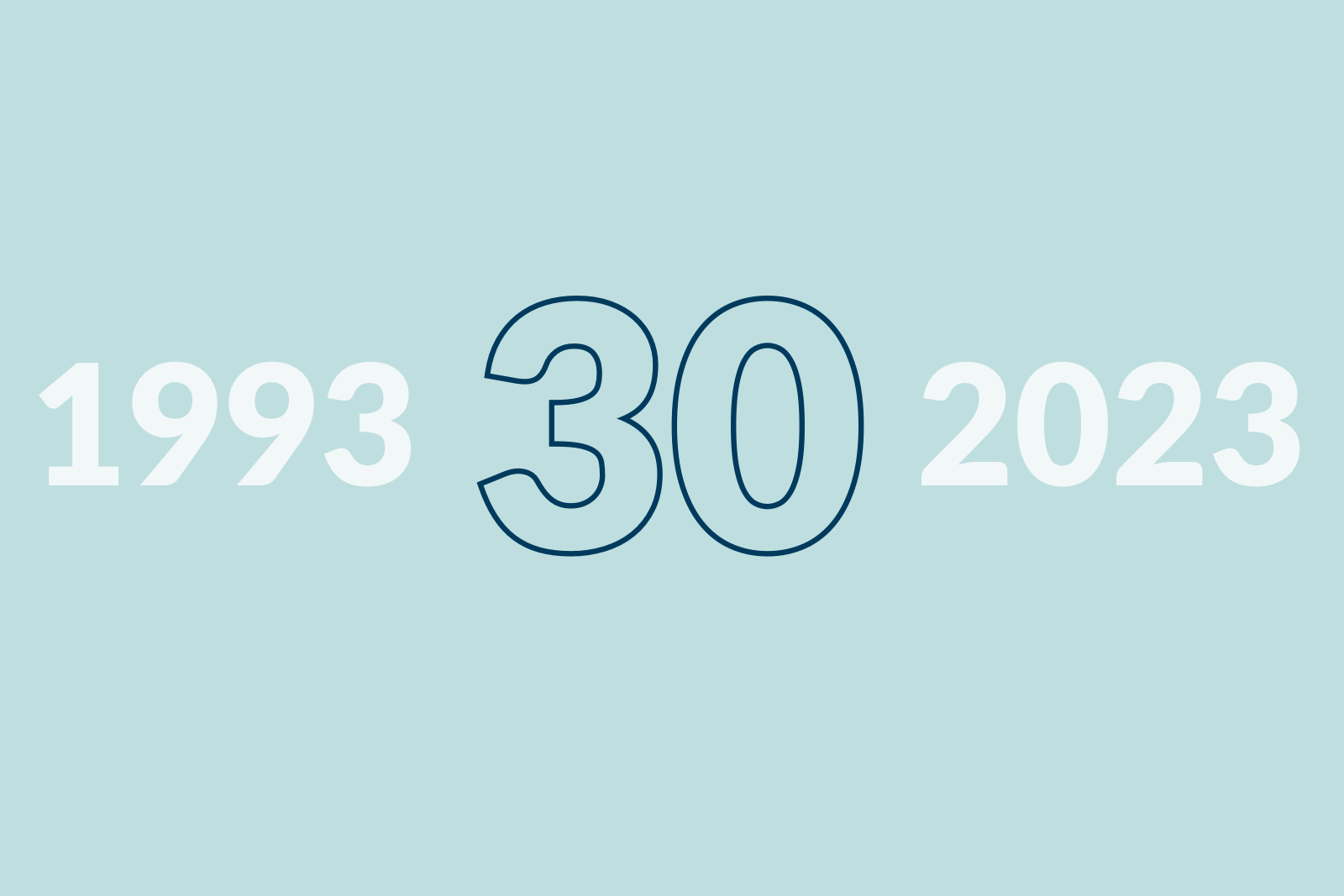Measuring Client Relationships in Decades


Roundtable Discussion — Jon Fjalstad, Tyler Love and Courtney Wendell
The Lacek Group is well into its third decade of providing data-driven loyalty, experience, and customer engagement strategies to myriad clients around the world. In short, this Ogilvy Experience agency is expert at the whole topic of loyalty. And, unsurprisingly, a number of its clients show their ongoing loyalty to Lacek. Many Lacek clients have worked with the agency for more than a decade—and some for nearly two. Some client contacts, after moving to new employers, seek out Lacek’s counsel to strengthen loyalty practices at their new gigs. How does the Lacek team forge such lasting, mutually beneficial partnerships—and what might you learn that could be applied to your own client or agency relationships? Read on for a discussion among three of Lacek’s experienced account execs on those questions and more.
COURTNEY WENDELL: We’ve joked so many times that relationships with clients are like marriages—and we just need to keep being better partners to each other over time. I think that’s true. We’re constantly focusing on not just sort of sitting back and continuing to use the same ideas and approaches. That won’t work. We need to constantly evolve and innovate, making sure we’re ahead of what our clients need.
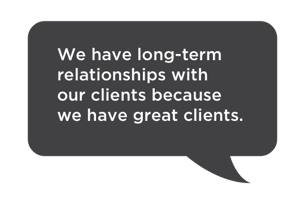 TYLER LOVE: And then there’s the part where we have long-term relationships with our clients because we have great clients.
TYLER LOVE: And then there’s the part where we have long-term relationships with our clients because we have great clients.
JON FJALSTAD: In a way, it’s pretty simple: When we speak of customers in our loyalty programs, we sometimes boil down our process this way: Know them, show them, and reward or recognize them. We want to know how members behave. And we want to demonstrate we know them by personalizing our communications with them. Ultimately, we want to reward them with things they like—whether it’s program points or another benefit.
Client relationships are similar. We work hard to get to know our clients. We have long phone conversations. We take them to dinner. We try to learn about their personal lives as well as their businesses. The fuller our pictures of them as colleagues and as people, the better our relationships are over time. And we want to be transparent in our wish to know them, not just their business needs. Then we reward them by viewing their successes as our successes.
TYLER: I’ve often heard our clients say that one “reward” they appreciate is that everything we do for them is measurable. So when they invest one dollar in the work we produce, they know what they’re getting in return. Sure—we’re really good at building out test plans and financial models and performance dashboards. But, I mean, the marketing we do is extremely measurable. Our clients can go back to their leadership and show the value we’re bringing to their company. That makes their job easier.
JON: So true. When campaigns do well, our clients get recognized in their organizations for the work we do together. So it’s a win-win—for us and for them. I think that helps foster the long-term relationships we’re talking about. 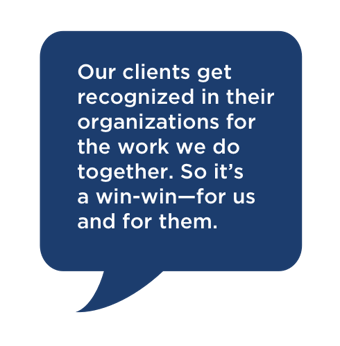
TYLER: As Bill Baker, our fearless leader here at Lacek, is always saying: Good work begets the opportunity for more work. We do take a lot of pride in the work we do. We produce for our clients. And that’s reflected in their willingness to keep working with us year after year.
COURTNEY: Also, we’re working with brands we can truly be passionate about. Brands we’re really happy to represent. My work with Marriott has made the world feel so much more attainable—as if I could go anywhere. And that’s exactly the experience we’re working to create for our members too. It’s easy to build strong relationships when you work with great brands. I don’t mean the work itself is always easy.
TYLER: For sure. Let’s face it: Things don’t always go according to plan. From time to time, we make mistakes. But all relationships are based on trust, and we have a formalized process when errors come up. We share them immediately with our client, and we have an internal review across the company to make sure we don’t repeat the issue for any client.
In a way, navigating those harder moments is when trust is really cemented. That’s when we do some quick problem-solving alongside our clients and build a rapport. And as long as you continue to build on that trust, you’re creating friendships with these people you’re working with day in and day out. They’re working on the other side of the fence, but you’re all working toward a common goal.
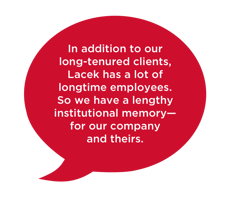 COURTNEY: Such a good point. Also, in addition to our long-tenured clients, Lacek has a lot of longtime employees. So we have a lengthy institutional memory—for our company and theirs. We’ve seen what they’ve been through. We’ve often been with them through a changing group of client leaders. Sometimes we’re even helping new hires onboard, or we’re backfilling roles until they make new hires. Many Lacek employees have even worked on-site with client teams.
COURTNEY: Such a good point. Also, in addition to our long-tenured clients, Lacek has a lot of longtime employees. So we have a lengthy institutional memory—for our company and theirs. We’ve seen what they’ve been through. We’ve often been with them through a changing group of client leaders. Sometimes we’re even helping new hires onboard, or we’re backfilling roles until they make new hires. Many Lacek employees have even worked on-site with client teams.
JON: I’d expand on a couple of key things you each highlighted: When a client contact changes, the new person quickly realizes we know as much as and sometimes more than other people in their organization about marketing to their customers. So they usually appreciate our help. I say usually because I’ll share an example later of a time that wasn’t the case.
COURTNEY: Wait, what?
TYLER: You’re just going to leave us hanging?!
JON: Yep. Anyway, back to my point. It’s important we don’t come across as know-it-alls. We have to treat new client relationships as delicate. Sometimes client contacts are sort of nervous about how they’re perceived by new colleagues. They want to come across as experts. So we need to share information and build relationships with them in a way that helps them win.
Tyler, you mentioned how we handle errors. Earlier in my career, when an error would happen, I’d wonder, Should I tell them? But honesty is the best policy, of course. We tell clients right away, and we tell them how we’re going to fix the issue. What’s more, we’re going to turn that mistake into a long-term win for us and for them.
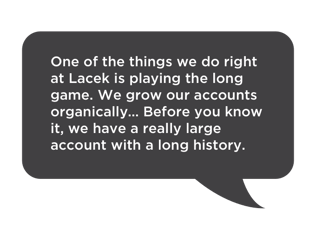 TYLER: Our mission is to make sure our clients win. We want them to produce the best work—and the best results—possible. We want to be a part of their success. One of the things we do right at Lacek is playing the long game. We grow our accounts organically. We put our best work forward, and we hope our clients like it enough to share it across the organization. Hopefully, other people in that organization see our work and ask for our help too. Before you know it, we have a really large account with a long history. Sales isn’t who we are, how we operate. We only advocate for work we truly believe is in our clients’ best interests. When we make it obvious that we’re really looking out for them, it further builds trust.
TYLER: Our mission is to make sure our clients win. We want them to produce the best work—and the best results—possible. We want to be a part of their success. One of the things we do right at Lacek is playing the long game. We grow our accounts organically. We put our best work forward, and we hope our clients like it enough to share it across the organization. Hopefully, other people in that organization see our work and ask for our help too. Before you know it, we have a really large account with a long history. Sales isn’t who we are, how we operate. We only advocate for work we truly believe is in our clients’ best interests. When we make it obvious that we’re really looking out for them, it further builds trust.
JON: Most of our clients also work with other agencies and vendors. We often hear how tired they are of them always selling—looking for the next quick win for themselves.
COURTNEY: Yes, definitely. Now back to this dangling example, Jon. Spill it.
JON: OK, OK. . . . We had a new client contact at a company we’d worked with for a long time. Within three or four months, he went from “I need you guys” to “I’m doing an RFP.” The rationale was that we knew too much. He felt uncomfortable with what he perceived as a knowledge imbalance. We were really trying to help this person win internally, but he wanted to grow and learn with another agency. He later came back to ask for our expertise when he took another job.
COURTNEY: Wow. Usually a client appreciates it when a partner understands their business—generally that’s a good thing! I know our contacts at Marriott feel that way.
Pivoting to another positive: Working on that account for a long time, I’ve had the opportunity to attend a lot of Marriott Bonvoy Moments events. It’s always so exciting to see members experiencing the program’s marquee benefits. When I talk to them, I usually think I could probably hire them. These Marriott Bonvoy Elite members know as much as we do about the program—and we literally built it!
TYLER: So which events should I be envious about?
COURTNEY: One of my favorites was a party in Minneapolis for the 2018 Super Bowl. To be clear, I’m a pretty interested football fan. But to see these super-intense football fans was way more rewarding than even meeting Aaron Rodgers, which was pretty cool too. It’s also a kick to see Moments experiences at the US Open. They spoil people so thoroughly, and you’re just right up front with celebrities all around you. It’s amazing.
And then there are the times we host Marriott folks here. One year a bunch of them were here in August—right in the middle of the Minnesota State Fair. These New Yorkers were pretty skeptical about iconic fair features. Like, “OK, farm animals and food on a stick.” But we took up the challenge to convince them how great it is, and we had the most fun. It became an annual event thereafter—purple fanny packs and all.
TYLER: Making connections and having fun is so important. Client dinners are probably the best way to get to know people we work with. We spend a huge portion of each day working with them on common goals, but we’re focusing on the tasks at hand. Spending time together in a casual setting makes us appreciate one another more. I’ve had lots of sidesplitting conversations over dinners that probably annoyed a lot of other restaurant patrons because of our loud laughter. But those moments are a part of what has helped us grow strong relationships over the years.
JON: OK, here’s a jaw-dropper: We signed a new client—a big win. This was back in 2004 or so. And we decided to host a get-to-know-you event. The main client decided we’d all go on a spa day. So, imagine us all—essentially strangers—arriving at the spa. The men go one way, the women go another, and then we meet in the middle all wearing fluffy robes. Awkward, right? We all had our massages, and it was just . . . odd. In that awkward moment, however, we saw each other as equal humans, and that client–agency relationship ended up being one of our best.
COURTNEY: I wish you’d told me about that sooner! We had a spa day that was equally as … interesting at first. Turned out to be wonderful, though.
TYLER: I think I’m missing out here. Maybe I have to talk to my clients about getting a spa day scheduled.
COURTNEY: I’d recommend waiting a bit as we transition out of COVID-19 concerns!
TYLER: Definitely. You know, at the beginning of the pandemic shutdown, I wouldn’t have guessed there’d be silver linings to client relationships. My clients aren’t local, so seeing them in person required travel. But with Zoom and Microsoft Teams, I’m seeing our clients “face to face” much more than I ever had before. That’s actually strengthened our relationships. Being in each other’s homes remotely, hearing each other’s kids—it’s humanized the workday in new ways and really fostered a new kind of collaborative atmosphere.
JON: I remember being on a call when a CMO was presenting, and her dog was barking like crazy. So she just reached down and picked up her dog for us to see. Once something like that happens, you let your guard down. Everybody has the same fear of things like that happening.
COURTNEY: The three of us all work with clients in the travel industry, which took a massive hit during the pandemic. But we were there to help see them through it. We were going to get the work done, no matter what. With a huge number of team members on furlough, they leaned on us even more during that time to fill gaps.
TYLER: Yeah, I think we kept our travel industry clients because of the relationships we’d cultivated with them over the years. We just went ahead and did the work they needed—whether or not they were worried about keeping the lights on. We were going to help them through it.
COURTNEY: Well, with Marriott Bonvoy, we just stepped in where they had gaps. We rolled up our sleeves and got things done while they had very few employees in action. And then, as soon as they could ramp things back up and hire again, we were there to help onboard new team members or help returning people pick up where they left off.
JON: One travel client I work with had zero customers during the pandemic. No customers, and no revenue. But they still kept us around. And, yes, we did more work than we were getting paid for. But at one point they actually came to us and said, “We feel bad for you too. So we found some money and here’s another project for you.” That supportive relationship went both ways during a challenging time for all of us.
COURTNEY: Some difficulties during the pandemic were really just challenges we run into all the time—with the volume turned up.
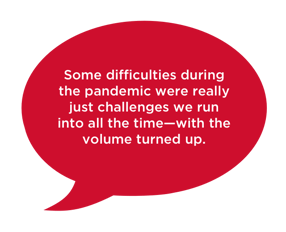 JON: For sure. One example is probably client turnover, which we touched on a bit earlier. When a client contact you’ve known for a long time, who knows you and knows the value Lacek brings, departs and somebody else steps in, it’s like starting all over again. One strategy we embrace is helping them succeed right away. Quick wins help them look good to their bosses, which keeps the new client contact feeling good about our contribution.
JON: For sure. One example is probably client turnover, which we touched on a bit earlier. When a client contact you’ve known for a long time, who knows you and knows the value Lacek brings, departs and somebody else steps in, it’s like starting all over again. One strategy we embrace is helping them succeed right away. Quick wins help them look good to their bosses, which keeps the new client contact feeling good about our contribution.
COURTNEY: The flip side is staff turnover here at Lacek. That’s challenging because some of the key account people are on the phone with our clients every day. And if they move on—either to other responsibilities within Lacek or to another organization—we have a big hole. Clients can get a bit nervous, so we need to fill those voids quickly.
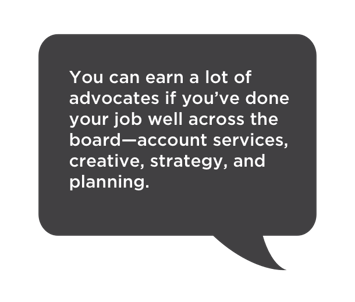 TYLER: Lacek is lucky to have a pretty low turnover rate, comparatively. Mostly, we’re managing the challenge of turnover on the client side. That can be especially rough when it comes to new leadership, because most new people want to sort of shake things up and start fresh. That attitude can be challenging for an incumbent agency—but so far we’ve got a perfect record maintaining the business when we’re in that position. That’s probably due to the trust we’ve built. Also, the larger marketing organizations our clients work with tend to do everything in their power to make sure the company holds on to us because we know our stuff and we’re good partners. You earn a lot of advocates if you’ve done your job well across the board—account services, creative, strategy, and planning.
TYLER: Lacek is lucky to have a pretty low turnover rate, comparatively. Mostly, we’re managing the challenge of turnover on the client side. That can be especially rough when it comes to new leadership, because most new people want to sort of shake things up and start fresh. That attitude can be challenging for an incumbent agency—but so far we’ve got a perfect record maintaining the business when we’re in that position. That’s probably due to the trust we’ve built. Also, the larger marketing organizations our clients work with tend to do everything in their power to make sure the company holds on to us because we know our stuff and we’re good partners. You earn a lot of advocates if you’ve done your job well across the board—account services, creative, strategy, and planning.
COURTNEY: As Tyler said earlier, we have great and lasting client relationships because we have such great clients. But also because we don’t take relationships for granted.
JON: Absolutely. We stay focused on doing great work, of course, but also on being the best-possible partners for their loyalty journeys.
Jon Fjalstad, SVP, group account director; Tyler Love, SVP, group account director; and Courtney Wendell, SVP, account director, boast a collective 59 years with The Lacek Group, a Minneapolis-based, data-driven loyalty, experience, and customer engagement agency that has been delivering personalization for its world-class clients for more than 30 years. The Lacek Group is an Ogilvy company.
